You're using an outdated browser. Please upgrade to a modern browser for the best experience.
Please note this is an old version of this entry, which may differ significantly from the current revision.
Subjects:
Engineering, Electrical & Electronic
There are two basic types of acoustic waves: SAW and BAW. When the acoustic wave is confined and travels at the interface between the substrate and the air, it is called a surface acoustic wave (SAW), like the ripples observed on the water surface hit by a stone. In contrast, a wave that propagates in the bulk of the material of the medium and exists in most of the volume of the media, is called a bulk acoustic wave (BAW), like a sound wave that travels through the air.
- bulk acoustic wave (BAW)
- coupled resonators
1. Sensors Based on Weakly Coupled BAW Resonators
In the sensors based on the weakly coupled resonators, that are using the amplitude change or the AR change to measure the physical quantity change in the environment, the sensitivity will be largely enhanced compared to a sensor using resonant frequency changes as an output metric. The group of Professor Ashwin A. Seshia of Microsystems Technology in the Department of Engineering at Cambridge University focuses on the relevant study, and the related work is represented below.
Lin et al. developed a mass sensor based on the coupled BAW resonators [39,40] where the two square-plate BAW resonators were coupled together by a long and thin beam and operated in the extensional mode shown in Figure 1. In this device, one resonator was used for transduction while the other one was used for mass perturbation. A Cr film [39] was deposited on the surface of the resonator as a small mass perturbation on the system, and then a frequency shift (about 34 Hz/ng in air and 32 Hz/ng in vacuum for the in-phase mode; about 36.7 Hz/ng in air and 37.3 Hz/ng in vacuum for the out-of-phase mode) was observed due to the thin film deposition. Then to explore the feasibility of the coupled BAW resonators for biochemical sensing application, the streptavidin-coated polystyrene microbeads (SCPM) [40] and High Five insect cells [40] were subsequently applied to the functionalized surface of one resonator as a mass perturbation, shown in Figure 2.
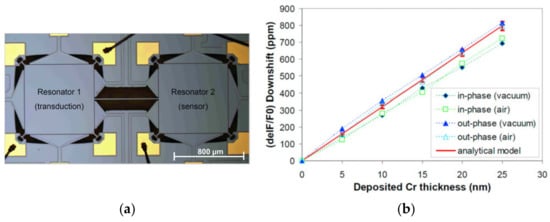
Figure 1. (a) Optical micrograph of the 2-DoF BAW resonator system; (b) Comparison between the analytical frequency shift and the measured one with respect to the deposited Cr film thickness.

Figure 2. Optical micrograph of attached analytes. (a) SCPMs with diameters of 5.61 μm and 15.68 μm; (b) High Five insect cells.
Figure 3 shows the relationship between the frequency shift and the number of analytes attached to the resonator. Figure 27a shows a good match between the theory and the measurement result based on the analytes of SPCMs. In Figure 3b the frequency shift caused by the attached insect cells, −12 Hz/cell (−3.89 ppm/cell), is illustrated [40], indicating the potential of this device to serve as a biochemical sensor.
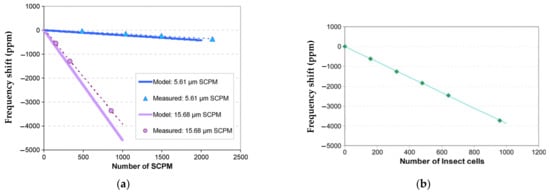
Figure 3. Relationship between the frequency shift and the number of analytes attached to the resonator from. (a) SCPMs; (b) High Five insect cells.
However, compared to the detection limit of the BAW resonators operated in liquid (i.e., SMR (0.01 ng/cm2) [116] and C-FBARs (1.78 ng/cm2) [117]), the detection limit of this device operating in the air (1.46 ng/cm2 or 36 ng/cm2) is not superior. To improve the sensitivity, further miniaturization of the proof mass or a secondary label of mass may be needed.
The conventional frequency shift is used to characterize the sensitivity in the work shown above, but for now, there have already been two studies from one group on the weakly coupled BAW resonators utilizing mode localization as the sensing mechanism. Chellasivalingam et al. [41,42] coupled two identical square-plate resonators by a short beam which are both operated in the WG mode. The piezoelectric actuation and sensing mechanisms were adopted here.
The device proposed in [41] was used as a mass sensor to detect the Polystyrene Latex (PSL) particles with a diameter of about 296 nm. The results showed that the normalized sensitivity based on the AR shift (422) was much larger than that based on the conventional frequency shift (−0.17) in a vacuum as shown in Figure 28a. For the device proposed in [42], it was used for aerosol detection, and the soot particles of 100 nm in diameter were applied to the surface of one resonator as a mass perturbation. The normalized sensitivity obtained in a vacuum (0.0735 for frequency shift; 148.22 for amplitude ratio shift) is shown in Figure 4b. The minimum mass it can detect based on the AR and frequency shift is 367.8 pg and 2.16 pg, respectively.
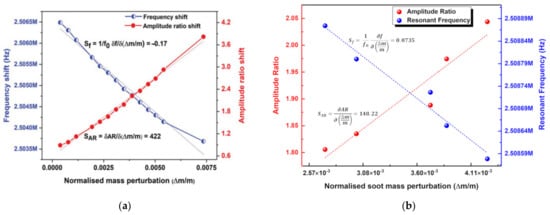
Figure 4. (a) Normalized sensitivity based on frequency shift and amplitude ratio shift (Reprinted with permission from Ref. [41]); (b) Normalized sensitivity based on frequency shift and amplitude ratio shift from.
Unlike the device described in [39,40], the sensitivity of the BAW resonators based on mode localization was improved considerably. However, as for the device proposed in the work [40], the minimum detection limit based on mode localization was much larger than that based on frequency shift which should be further researched.
To summarize, both frequency shift and mode localization have been proposed for characterizing the sensitivity of weakly coupled BAW resonators, and Table 1 shows a performance comparison of these reported works. The coupled BAW resonators based on mode localization showed great potential for enhanced sensitivity proved in theory and practical work shown above and worth further investigation.
Table 1. Performance comparison of the reported 2-DoF coupled BAW MEMS resonators as mass sensors.
| References | [39] | [40] | [41,42] |
|---|---|---|---|
| Vibration mode | Extensional mode | Extensional mode | WG mode |
| Actuation way | Capacitive | Capacitive | Piezoelectric |
| Sensing way | Piezoresistive | Piezoresistive | Piezoelectric |
| Frequency (MHz) | 5.492, 5.423 | 5.492; 3.145 | ~2.5 |
| Q factors | 5139, 8505 | 5139; 8676 | 1773.8 |
| Mass perturbation | Cr film | Microbeads and cells | Particles |
| Characterize sensitivity | Frequency shift | Frequency shift | Frequency shift; AR shift |
| Sensitivity | 34 Hz/ng | −12 Hz/cell | 0.0735; 148.22 |
| Detection limit | Not mentioned | 1.46/36 ng/cm2; ~1.68 dried cells |
Not mentioned |
2. Oscillators Based on Coupled BAW Resonators
The group of Professor Joshua E.-Y. Lee of the Department of Electronic Engineering at the City University of Hong Kong is carrying out the relevant study, and so is the group of Professor Clark T.-C. Nguyen in the Department of Electrical Engineering and Computer Sciences at the University of California at Berkeley. The related work is indicated below.
Iqbal et al. focused on the weakly coupled square-plate BAW resonators as oscillators, including 2-DoF and 3-DoF resonators, and resonators were diagonally coupled by a mechanical beam to make the piezoresistive sensing work the best [37]. The 1-DoF, 2-DoF and 3-DoF resonators were demonstrated to work at the same resonant frequencies with the in-phase extensional mode, and the synchronized oscillation was realized via a coupling beam with a half-wavelength. Besides, with the introduction of the coupling mechanism, a higher Q up to 120,000 (3-DoF) was achieved compared to the Q of the single resonator (60,000), as illustrated in Figure 5a.

Figure 5. (a) Comparison of Q factors among the single, 2-DoF and 3-DoF square-plate BAW resonators as the drain current (Reprinted with permission from Ref. [37]); (b) Comparison of Q factors between the single and 2-DoF disk BAW resonators with bias current increasing.
Iqbal et al. then studied a 2-DoF disk BAW resonator device as oscillators [38], and the synchronization was also achieved by a coupling beam at half of the wavelength. The Q factor achieved here was about 184,000, two times higher Q factor than the Q of 1-DoF disk resonators, as illustrated in Figure 5b.
These two studies with similar results demonstrated the possibility of using weakly coupled BAW resonators with the extensional mode to work as an oscillator with an enhanced Q factor compared to single resonators. Based on this work, the weakly coupled BAW resonators operated at other lateral bulk vibration modes or using different transduction methods can be further researched to achieve a novel filter with a higher Q factor.
Besides, the device developed by Demirci et al. [73] has the potential to be an oscillator. As shown in Figure 6, there are two devices: a 3-DoF strongly coupled BAW resonator system with anchors at the center and a 7-DoF strongly coupled BAW resonator system with anchors connecting to the resonator body by a suspension beam, and they are operated in the out-of-plane transverse mode at 70 MHz.

Figure 6. (a) SEM image of a 7-DoF strongly coupled BAW resonator system with anchors at the center; (b) FEM simulated out-of-plane motion of the coupled resonator systems; (c) Frequency response of several multi-DoF coupled resonators.
By mechanically coupling resonators together, the total output current is boosted by combining the output current from each resonator in the coupled system, as shown in Figure 6c. The work in [73] indeed achieved a Q factor of more than 9000 and a reduction in the motional resistance (480 Ω, more than 5.9 times smaller than that of a 1-DoF resonator device) by mechanically coupling several resonators together, instead of shrinking the transduction gap between the electrode and the resonator body or increasing DC bias. In this way, the power handling capability was enhanced, the linearity of the system was maintained, and the motional resistance versus the dynamic range tradeoff often occurs when scaling was broken.
Lin et al. designed several multi-DoF strongly coupled disk filters operating at the first in-phase WG mode [118], and taking a 3-DoF system as an example, Figure 7a shows the disk resonators were strongly coupled by a mechanical beam with half-wavelength. Figure 7b indicates the operating frequencies were all around 61 MHz and the Q factors for 3-DoF, 5-DoF, and 9-DoF resonators were all about 120,000 (pretty high) although the single resonator could achieve a higher Q factor of 161,000. When the oscillator was divided down to 10 MHz, the phase noise of −138 dBc/Hz at 1 kHz offset and −151 dBc/Hz at far from carrier offset were achieved here, and there was a 13 dB and 4 dB improvement over the previously reported work on the single resonator-based oscillators [118], as shown in Figure 7c. That well verified the utility of coupled resonator-based filters which deserved to be further explored.

Figure 7. (a) Schematic of a 3-DoF strongly coupled disk resonator system with the equivalent electric circuit; (b) Measured frequency response for several multi-DoF disk resonator systems; (c) Relationship between the offset frequency and phase noise.
3. Filters Based on Coupled BAW Resonators
There is one study on the coupled BAW resonators based filters and the group of Professor Clark T.-C. Nguyen in the Department of Electrical Engineering and Computer Sciences at the University of California at Berkeley is carrying out the relevant research, and the related work is illustrated below.
Figure 8 shows a 2-DoF coupled BAW resonator system with anchors at the center of the resonator body, and the radial contour mode is chosen as the operation mode, consisting of out-of-phase and in-phase modes. Ozgurluk et al. studied the 2-DoF BAW resonator system as a filter, and to increase the output motional current, more resonators were then coupled and operated at the in-phase radial contour mode [80], shown in Figure 8. There were 96 disks strongly coupled by 110 mechanical beams, and the coupling beam is designed to equal half-wavelength [77]. Due to the possibility of structural asymmetry in weakly coupled structures, strong coupling is adopted here to ensure that all resonators vibrate uniformly at one mode frequency, hence the output currents of each resonator in the coupled system can sum constructively [80]. Besides, strong coupling can also eliminate non-uniform reductions in the motional resistance which normally occurs in the weakly coupled system [77]. Finally, a 0.1% bandwidth 223.4 MHz MEMS filter was achieved with a 2.7 dB insertion loss of the passband and a 50 dB stopband rejection.
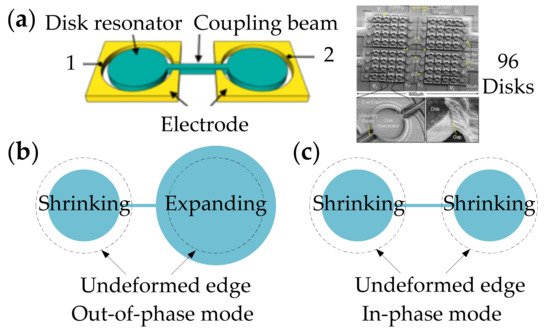
Figure 8. (a) Schematic and SEM image of a 2-DoF and 96-DoF coupled BAW disk resonator filter system; (b) Revised schematic of the out-of-phase radial contour mode shape; (c) Revised schematic of the in-phase radial contour mode shape.
Compared with the single disk resonator, the coupled disk resonators achieve a lower motional resistance. Figure 9 shows a comparison of frequency spectra between a 30-DoF disk system and a single disk system. The Q factor obtained for the 30-DoF disk resonator here was 8815, and the motional resistance (1180 Ω) was about 9 times lower than that of a filter based on a single disk resonator. That verified the feasibility of using coupled-resonator design.
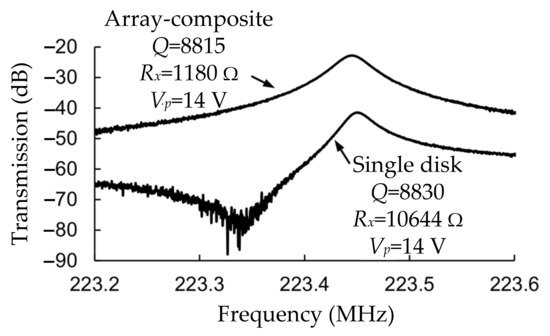
Figure 9. A comparison of frequency spectra between a 30-DoF disk system and a single disk system.
A small transduction gap of 39 nm (even reach to below 10 nm) was adopted in this work to reduce the motional resistance, thereby improving the electromechanical efficiency, which was a landmark for the capacitively transduced MEMS resonators.
This entry is adapted from the peer-reviewed paper 10.3390/s22103857
This entry is offline, you can click here to edit this entry!
